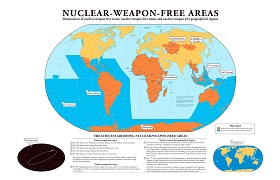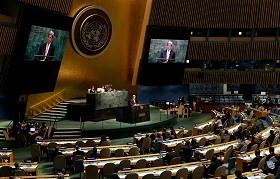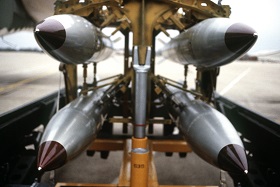Central Asian Nuclear Weapon Free Zone: Greater Security for the Region?
Semipalatinsk Test Site, Kazakhstan
(votes: 1, rating: 5) |
(1 vote) |
Consultant at PIR-Center for Policy Studies
Held from April 27 to May 22 in New York, the Non-Proliferation Treaty (NPT) Review Conference saw Russia and China declare their ratification of the Protocol to the Treaty on a Central Asian Nuclear Weapon Free Zone (CANWFZ). Barack Obama sent the Protocol to the Senate, and Great Britain and France have already done their bit. Although the debate over several CANWFZ Treaty provisions took many years, four out of five nuclear powers now provide the Central Asian republics with negative security guarantees, meaning that they are committed to nonproliferation and disarmament principles even in periods of heightened tensions or dispute. But will Central Asia’s security risks abate after this nuclear-free zone comes into force?
Held from April 27 to May 22 in New York, the Non-Proliferation Treaty (NPT) Review Conference saw Russia and China declare their ratification of the Protocol to the Treaty on a Central Asian Nuclear Weapon Free Zone (CANWFZ). Barack Obama sent the Protocol to the Senate, and Great Britain and France have already done their bit. Although the debate over several CANWFZ Treaty provisions took many years, four out of five nuclear powers now provide the Central Asian republics with negative security guarantees, meaning that they are committed to nonproliferation and disarmament principles even in periods of heightened tensions or dispute. But will Central Asia’s security risks abate after this nuclear-free zone comes into force?
Lost in Interpretation
Having supported the idea of a nuclear-free zone for Central Asia back in 1997, Russia, Great Britain and France did not insist on amendments when ratifying the CANWFZ Treaty Protocol. However, in May 2014 at the 3rd Session of the NPT Review Conference Preparatory Committee, these three countries made interpretative declarations in order to remove any ambiguity. Russia clarified that it will abandon the treaty in the event of a military attack against its territory or its allies. Other instances include the entry or transit of ships and aircraft carrying nuclear weapons into the ports and airports of Central Asian states. The reservations expressed by Great Britain and France suggest that Articles 3 and 4 of the CANWFZ Treaty, prohibiting Central Asian countries from developing, producing and stockpiling nuclear weapons, shall be strictly observed, while Article 12, which specifies that the document shall not impact the republics’ rights and obligations under other treaties, shall not serve as a basis for the deployment of Russian nuclear missiles under the Collective Security Treaty (CST). Beijing chose to sign the treaty without reservations to underline its support to a nuclear-free zone in Central Asia.
Americans usually add interpretative declarations when such agreements pass the Senate, and it seems that this will be the case with the CANWFZ Treaty Protocol. The coordinated and simultaneous signature of the Protocol by the five-member nuclear club in 2014 raises the hope that U.S. senators will join in, although reality may work out quite differently.
In 2011, the U.S. Senate received protocols to treaties on nuclear-free zones in Africa (Treaty of Pelindaba) and the Southern Pacific (Treaty of Raratonga), which were shelved. Nuclear nonproliferation and arms control have never been priorities for this Senate. Besides, it is controlled by the Republicans reluctant to approve any initiative launched by President Obama, which risks seriously delaying approval of CANWFZ by U.S. lawmakers.
The United States is usually slow to ratify nuclear-free zone protocols relating to any part of the world because they dislike documents that have the potential to limit their capacity for the use of force. Given the already aggravated relations between the United States and Russia over Ukraine, this confrontation could spread to other parts of the post-Soviet space. Hence, apprehensive of Russia’s stronger Russian positions in Central Asia after the ISAF operation concludes, and its reduced engagement in the region, Washington may recall its complaints about Article 12 of the CANWFZ Treaty, which is interpreted by the West as a possible pretext for Russia to deploy nuclear weapons in Central Asia.
Central Asian Nuclear-Free Zone or CSTO?
When the Central Asian states proposed the nuclear-free zone in the mid-1990s, the nuclear powers did not hesitate to support the initiative. However, while the republics were still harmonizing its principles, in 2002 France, Great Britain and the United States voiced their reservations [1].
Their biggest concern was Article 12, which specifies that the Treaty shall not affect participants’ rights and obligations under previously concluded agreements. Washington, London and Paris feared that the CST of 1992 may allow Russia to deploy nuclear weapons in Central Asian countries, most of which are CSTO members. Indeed, Article 4 of the CST says that aggression by a state or group of states against treaty participants shall be regarded as an act of aggression against all signatories and full support, including military assistance, shall be rendered to the country under attack.
Washington insisted on removing Article 12, a move that Russia and the Central Asian states considered unacceptable. Moscow deems it important if it is to preserve its influence in the region. Besides, this provision equalizes the capabilities of Russia and NATO, which could bolster its regional presence through expanding its network of military bases.
The Central Asian republics require Article 12 in order to be sure that they will be able to call on Moscow for help either through the CSTO or bilaterally if a serious security threat occurs.
Security in Exchange for Nonnuclear Status
Washington, London and Paris feared that the CST of 1992 may allow Russia to deploy nuclear weapons in Central Asian countries.
The history of Kazakhstan’s nuclear disarmament vividly exemplifies the importance of Russian military support to Central Asian countries in extremis. In 1991, the Kazakh authorities could hardly have imagined a regional NWFZ, and rather intended to preserve their nuclear status, since they were left with 1,040 nuclear warheads after the USSR breakup. Nursultan Nazarbayev even said that his country has the right to join the nuclear club because nuclear tests near its city of Semipalatinsk began 18 years before the NPT was signed [2].
It was only after the Tashkent Summit in May 1992, where Russia, Kazakhstan, Armenia, Kyrgyzstan, Tajikistan and Uzbekistan signed the Collective Security Treaty providing those much-coveted security guarantees that Kazakhstan agreed to join the NPT as a nonnuclear state. In fact, it was the CST that prompted Nazarbayev to change his stance, and even to say that he was ready to consider allowing Russia to deploy nuclear missiles on his territory, because under the CST Russia is his country’s political and military ally.
The CANWFZ initiative was formally proposed by Uzbek President Islam Karimov back in 1993. But could Central Asia’s NWFZ have emerged without the CST, which commits Russia to aiding its allies?
Buffer Zone to Guard against Nuclear Danger
The Central Asian countries crave legal recognition of their regional nuclear-free zone by the nuclear five but also want their previous agreements to remain intact, which is frequently criticized as connivance with Moscow. Nevertheless, in 2006 the Central Asian states signed the CANWFZ Treaty in Semipalatinsk, and their parliaments ratified it in 2009, officially unveiling the nuclear-free zone and underlining the fact that the regional need for it is of greater significance than Western grievances.
Central Asia is surrounded by both recognized and unrecognized nuclear powers, i.e. Russia and China, India and Pakistan, and it also borders with Iran, suspected of having nuclear aspirations – a neighborhood that generates additional risks to regional security. So, a Central Asian nuclear-free zone should guarantee that nuclear states will not deploy their nukes in that area, while also preventing other states and non-state entities from doing so.
The CANWFZ initiative was formally proposed by Uzbek President Islam Karimov back in 1993.
Another risk comes from nuclear trafficking. The IAEA documented 181 instances of illegal nuclear exports from Central Asia over the period 1993-2004. In most cases, quantities were insignificant but sufficient for a dirty bomb. In 2003, five attempts were recorded in Kazakhstan, most involving Cesium-137. In 2004 in Kyrgyzstan, a trader was detained with a smoke alarm containing radioactive plutonium. In the same year, Tajik law enforcers arrested an Uzbek with a capsule holding radioactive plutonium. In 2006, a similar incident took place in Tajikistan, when eight people were arrested during an attempt to sell three containers of radioactive plutonium and one container of radioactive cesium for USD 400,000. In 2008, tourists from the Xinjiang Uyghur Autonomous Region bought 274 kg of depleted uranium for USD 200 on the Kyrgyz black market and took it back to China for resale.
A major risk is posed by terrorist groups that can obtain nuclear materials illegally and use them in an attack. However, trafficking attempts have so far been foiled by regional law enforcers, which only confirms the effectiveness of the CANWFZ Treaty, which obliges signatories to prevent anyone from obtaining, storing and possessing nuclear explosives.
In fact, Central Asia’s NWFZ has become a kind of cordon sanitaire against its nuclear neighbors, their possible plans to deploy nuclear weapons in border areas, and terrorist groups.
Central Asia’s NWFZ is a Special Case
The CANWFZ contains many unique provisions, and is in fact the first nonnuclear area in both the Northern Hemisphere and a region where nuclear weapons had been previously deployed. The Treaty is the first to mention uranium tailings dumps for the toxic byproducts of uranium mining, a major problem facing virtually all countries in the region, and compensation for damage caused by historic nuclear tests. Besides, the Treaty also obliges all participants to sign the IAEA Additional Protocol and fully observe the NPT during the initial 18 months after the document comes into effect.
However, the CANWFZ’s emergence was accompanied by unclear statements and numerous reservations, leading some experts to the conclusion that this is far from the ideal solution that can be rolled out elsewhere, accelerating similar initiatives in the Middle East or on the Korean Peninsula.
Conclusions:
1. The interpretative declarations of Russia, Great Britain and France when signing the negative guarantees protocol smoothed over CANWFZ-related tensions.
2. Ratification of the Protocol to the CANWFZ Treaty may be indefinitely delayed by the U.S. Senate due to its low priority compared to more pressing domestic problems, as well as aggravated relations with Russia.
The CANWFZ contains many unique provisions, and is in fact the first nonnuclear area in both the Northern Hemisphere.
3. Central Asian states want legal recognition of the nuclear-free zone by all members of the nuclear five with no impact on their previous agreements, such as the Collective Security Treaty. But the U.S. would not block the zone’s operation despite the lack of the Protocol ratification.
4. On the one hand, the CANWFZ protects the region from nuclear India and Pakistan and terrorism threats emanating primarily from Afghanistan, while also guaranteeing that the five recognized nuclear states will not deploy their nukes in the region. On the other, Central Asian countries, most of which are SCO members (Uzbekistan, Kazakhstan, Kyrgyzstan and Tajikistan), are also wary of the future accession of India and Pakistan. The United States, Great Britain and France may question CANWFZ’s efficiency if the Central Asian states consent to strengthening the SCO by two more nuclear states. Participation of India and Pakistan in the SCO will hardly threaten CANWFZ but the media would definitely discuss this process in a way that the Central Asian countries view as negative.
The CANWFZ Treaty is one of the few frameworks involving participation of all Central Asian states.
5. CANWFZ will obviously improve regional security and the nuclear nonproliferation regime, but Kyrgyzstan, Kazakhstan and Uzbekistan still face grave ecological problems related to uranium tailings dumps containing buried radioactive, toxic and other non-recyclable waste – the uranium mining legacy of the Soviet period. While the CANWFZ Treaty stipulates the republics’ intention to rehabilitate the contaminated territories, an effective solution has yet to be found.
6. The CANWFZ Treaty is one of the few frameworks involving participation of all Central Asian states. Annual discussions of the document might provide a foundation for intra-regional dialogue on problems that have yet to be resolved, both regarding the NWFZ and also other aspects of regional security and development.
1. Kutanayeva N. Problems and Prospects of the Central Asian Nuclear-Free Zone – Bishkek – 2014. Pp.134-135.
2. Ibid. P. 83
(votes: 1, rating: 5) |
(1 vote) |








